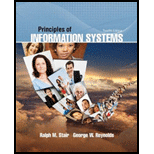
During which stage of the problem-solving process do you identify and define potential problems as well as investigate resource and environmental constraints?
- a. initiation stage
- b. intelligence stage
- c. design stage
- d. choice stage
The stage of problem-solving in which identification and definition of potential problems as well as investigating resource occurs is “Intelligence stage”.
Hence, the correct answer is option “B”.
Explanation of Solution
Problem solving process:
- The decision making phase of problem solving is been divided into three phases:
- Intelligence:
- It denotes first stage of decision making.
- The potential problems or chances are been defined in this stage.
- Design:
- It denotes second stage of decision making.
- The alternative solutions are been developed to problem and feasibility is evaluated.
- Choice:
- It denotes third stage of decision making.
- It requires choosing a course of action.
- Intelligence:
- The problem solving process goes outside decision making and includes other stages too.
- The stages involved in problem-solving process after decision making is shown below:
- Implementation stage:
- It denotes fourth stage of problem-solving.
- A solution is been put into effect in this stage.
- Monitoring stage:
- It denotes final stage of problem-solving.
- The decision makers assess implementation.
- Implementation stage:
Explanation for incorrect options:
a. Initiation stage:
There is no stage named as Initiation stage in problem-solving process.
Hence, the option “A” is wrong.
c. Design stage:
The alternative solutions are been developed to problem and feasibility is evaluated.
Hence, the option “C” is wrong.
d. Choice stage:
The choice stage requires choosing a course of action.
Hence, the option “D” is wrong.
Want to see more full solutions like this?
Chapter 10 Solutions
Principles of Information Systems (MindTap Course List)
- Discussion 1. Comment on your results. 2. Compare between the practical and theoretical results. 3. Find VB, Vc on the figure below: 3V V₁₁ R₁ B IR, R, IR, R www ΙΚΩ www www I 1.5KQ 18₁ 82002 R₁ 3.3KQ R₂ 2.2KQ E Darrow_forwardAgile1. a. Describe it and how it differs from other SDLC approachesb. List and describe the two primary terms for the agile processc. What are the three activities in the Construction phasearrow_forwardhow are youarrow_forward
- need help with thi Next, you are going to combine everything you've learned about HTML and CSS to make a static site portfolio piece. The page should first introduce yourself. The content is up to you, but should include a variety of HTML elements, not just text. This should be followed by an online (HTML-ified) version of your CV (Resume). The following is a minimum list of requirements you should have across all your content: Both pages should start with a CSS reset (imported into your CSS, not included in your HTML) Semantic use of HTML5 sectioning elements for page structure A variety other semantic HTML elements Meaningful use of Grid, Flexbox and the Box Model as appropriate for different layout components A table An image Good use of CSS Custom Properties (variables) Non-trivial use of CSS animation Use of pseudeo elements An accessible colour palette Use of media queries The focus of this course is development, not design. However, being able to replicate a provided design…arrow_forwardUsing the notationarrow_forwardyou can select multipy optionsarrow_forwardFor each of the following, decide whether the claim is True or False and select the True ones: Suppose we discover that the 3SAT can be solved in worst-case cubic time. Then it would mean that all problems in NP can also be solved in cubic time. If a problem can be solved using Dynamic Programming, then it is not NP-complete. Suppose X and Y are two NP-complete problems. Then, there must be a polynomial-time reduction from X to Y and also one from Y to X.arrow_forwardMaximum Independent Set problem is known to be NP-Complete. Suppose we have a graph G in which the maximum degree of each node is some constant c. Then, is the following greedy algorithm guaranteed to find an independent set whose size is within a constant factor of the optimal? 1) Initialize S = empty 2) Arbitrarily pick a vertex v, add v to S delete v and its neighbors from G 3) Repeat step 2 until G is empty Return S Yes Noarrow_forwardPlease help me answer this coding question in the images below for me(it is not a graded question):write the code using python and also provide the outputs requiredarrow_forwardarrow_back_iosSEE MORE QUESTIONSarrow_forward_ios
 Fundamentals of Information SystemsComputer ScienceISBN:9781305082168Author:Ralph Stair, George ReynoldsPublisher:Cengage Learning
Fundamentals of Information SystemsComputer ScienceISBN:9781305082168Author:Ralph Stair, George ReynoldsPublisher:Cengage Learning Principles of Information Systems (MindTap Course...Computer ScienceISBN:9781285867168Author:Ralph Stair, George ReynoldsPublisher:Cengage Learning
Principles of Information Systems (MindTap Course...Computer ScienceISBN:9781285867168Author:Ralph Stair, George ReynoldsPublisher:Cengage Learning Principles of Information Systems (MindTap Course...Computer ScienceISBN:9781305971776Author:Ralph Stair, George ReynoldsPublisher:Cengage Learning
Principles of Information Systems (MindTap Course...Computer ScienceISBN:9781305971776Author:Ralph Stair, George ReynoldsPublisher:Cengage Learning Enhanced Discovering Computers 2017 (Shelly Cashm...Computer ScienceISBN:9781305657458Author:Misty E. Vermaat, Susan L. Sebok, Steven M. Freund, Mark Frydenberg, Jennifer T. CampbellPublisher:Cengage Learning
Enhanced Discovering Computers 2017 (Shelly Cashm...Computer ScienceISBN:9781305657458Author:Misty E. Vermaat, Susan L. Sebok, Steven M. Freund, Mark Frydenberg, Jennifer T. CampbellPublisher:Cengage Learning Principles of Information Security (MindTap Cours...Computer ScienceISBN:9781337102063Author:Michael E. Whitman, Herbert J. MattordPublisher:Cengage Learning
Principles of Information Security (MindTap Cours...Computer ScienceISBN:9781337102063Author:Michael E. Whitman, Herbert J. MattordPublisher:Cengage Learning Database Systems: Design, Implementation, & Manag...Computer ScienceISBN:9781305627482Author:Carlos Coronel, Steven MorrisPublisher:Cengage Learning
Database Systems: Design, Implementation, & Manag...Computer ScienceISBN:9781305627482Author:Carlos Coronel, Steven MorrisPublisher:Cengage Learning





